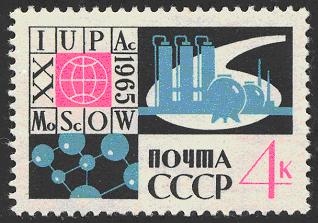|
|
Vol.
29 No. 1
January-February 2007
by
Dan Rabinovich
The
hobby of kings? The king of hobbies? Either way, stamp
collecting is certainly one of the most popular and international
hobbies, attracting people from all walks of life, regardless
of age, race, religion, or nationality. Many postage stamps
have been issued to commemorate events and educate the general
public on topics ranging from history and geography to art
and literature. A number of stamps also celebrate scientific
discoveries or honor well-known scientists and can be used
as simple yet powerful teaching tools in the classroom or
to illustrate a technical presentation. This
new section of Chemistry International will feature
interesting or visually appealing chemistry-related postage
stamps from different countries, and will thus underscore
the international character of both philately and our science.

The
postage stamp shown here was issued by the USSR on 15 June
1965 to publicize the 20th Congress of the International Union
of Pure and Applied Chemistry (IUPAC), held in Moscow a month
later (12-18 July). It is the only stamp that I am aware of
that has IUPAC as the central theme and it is also one of
my favorites: the names of both the organization and the host
city are spelled with chemical symbols! In addition, the stamp
shows a molecular diagram of an unidentified substance and
honors the chemical (petrochemical?) industry using a retort
as a background. Remarkably, especially for a stamp issued
more than 40 years ago, the bright rose ink used for the globe
diagram and the face value of the stamp (4 kopecs) are fluorescent!
Daniel
Rabinovich <[email protected]>
is a professor in the Department of Chemistry at The University
of North Carolina at Charlotte. His research interests include
synthetic and structural inorganic, organometallic and bioinorganic
chemistry. He is also the Editor of Philatelia Chimica
et Physica, a quarterly publication dedicated to the study
of postage stamps related to chemistry and physics <www.cpossu.org>.
Page
last modified 26 January 2007.
Copyright © 2003-2007 International Union of Pure and
Applied Chemistry.
Questions regarding the website, please contact [email protected]
|